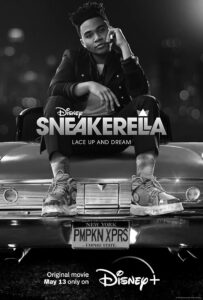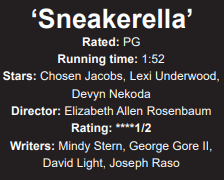
The Scene staff
People typically offer praise or criticism while they’re watching movies at home. But I hold off on all judgment until they’re over, then I give my feedback.
That’s what I’m going to do in this column.
This review looks at “Sneakerella,” a Disney Plus exclusive released in May. It’s mainly geared to sneaker culture, but it also appeals to other young audiences.
The movie is based on the classic “Cinderella” story with a modern twist. Innovations include gender swapping the main characters, utilizing a primarily Black cast and changing the location from a fairytale village to the streets of New York City.
The iconic glass slippers are replaced with a pair of kicks that resemble Timberland boots in absurd colors with mega-stuffed clear midsoles and outsoles.
The trailer gives the impression that the movie makes fun of sneaker culture and Black culture, but I think it presents a respectful view of both.
The original music contributes to the storyline, character and ambiance.
 At the beginning of the film, audiences are greeted with a bedazzling title card panning over the cityscape with a Morgan-Freeman-style voiceover explaining how fairytales don’t have to take place in a distant land and not all royals wear crowns.
At the beginning of the film, audiences are greeted with a bedazzling title card panning over the cityscape with a Morgan-Freeman-style voiceover explaining how fairytales don’t have to take place in a distant land and not all royals wear crowns.
The narrator provides a brief introduction to the main character, El, who is played by Chosen Jacobs. He’s a clerk in a shoe store owned by his stepfather, who belittles him and forces him to work long hours. He’s also bullied by his stepbrothers.
But El doesn’t give up on his dream of designing and making his own sneakers, which he wears to the King’s Charity Ball. He hopes to impress the King family of “sneaker royalty,” whose daughter, Kira, played by Lexi Underwood, is the “Sneaker Princess.”
At the ball, El’s innovative sneaker design draws attention. He also connects with Kira, and their dancing causes him to lose track of time. He fails to leave by midnight, as instructed by his fairy godfather, Gustavo.
The classic vehicle that Gustavo has loaned him gets towed by police, and his fancy threads get snagged on an escalator and ripped apart.
Like Cinderella, El loses one of his sneakers when he leaves the ball abruptly. Kira locates him through social media, and he’s recognized for his creativity and potential.
El works through more interference from his stepbrothers before finally getting an opportunity to meet with Kira’s father, the “Sneaker King,” an ex-NBA player with an Adidas deal who helps with his career.
Eventually, El takes over his stepfather’s shoe shop, where he displays and markets his own sneakers.
The movie is quite entertaining with strong character development. Cast members perform their roles convincingly. I would have liked to tweak the music a bit, but sweeping panoramic shots of New York City give the movie sparkle.
There are some magic moments in this poor boy-rich girl story, including the night El and Kira are dancing in their own world, just like in the original “Cinderella.”
The story celebrates the sneakers, music and fashion culture of New York, and the movie showcases Black creativity and perseverance.
“Sneakerella” reviews on social media are very mixed, with some critics finding the film deprecating of both sneaker culture and Black culture. As I already mentioned, I disagree, and particularly for sneakerheads, it’s well worth the hour and 52 minutes.
